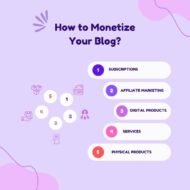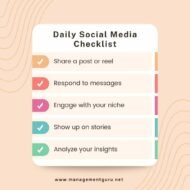Posted by Managementguru in Branding, How To, Marketing, Sales, SEO, Social Media
on May 5th, 2024 | 0 comments

I would like to list 7 key metrics for you to understand how Instagram algorithm has changed and how it works now in 2024. This will help you in focusing on what needs to be done with some clarity. Lets go. Hashtags ruled the kingdom, but now… I know we all went bald in an effort to catch hold of the right hashtags to take our posts/content in front of the right audience. But now hashtags take a back seat – while still they play a pivotal role in reaching the target audience , you need not scramble for 30 hashtags. Instagram advises creators to use between 3-5 hashtags on their posts. A later study has revealed that the highest count need not surpass 20. Captions weren’t crucial but now… Engaging captions are very important when it comes to Instagram as they increase interactions and are your key to discoverability. A strong caption will lure your audience compelling them to look what you have to offer in your reel / story/post. Negative captions sometimes work best for you. SEO had minimal impact but now… SEO keywords are growth game changers. The better your SEO game, the better the algorithm matches users’ queries with your content. One-type content was popular, but now… Using multiple content formats like reels, stories, carousel posts, live intreactions make people want more of your stuff. You have to make them feel your personal/business brand’s presence consistently yet subtly. Collaborations fell flat but now… Collaborations or Brand partenerships are the vibe of the day. If you are able to pitch your request for sponsorship bang-on, you are a winner. It all boils down how you have structured your Instagram account, your niche and follower count. Sometimes “follower count factor” becomes completely nullified if you have amazing skills that the sponsor needs. Follower count was the obsession but now… Community engagement is the new focus. You must be able to keep the visitors in your channel /page longer. For this to happen, you should have friendly chit chat with your followers, DM to their queries immediately, even visit their accounts and show your appreciation in return. Likes were the growth metric, but now… Saves and shares are the KPI’s when you want to gauge the success of your work on Instagram. The more your content is saved and shared the more is your reach. The ROI is practically measurable in this platform through the insights. How to “Beat” the Instagram Algorithm in 2024 #1: Consistently Share Instagram Reels #2: Encourage More Interactions with Instagram Stories Stickers #3: Drive Conversations with Engaging Captions #4: Add Hashtags and Keywords to Your Posts #5: Ask Followers To Add You to Their Favorites Feed #6: Cross-promote Your Instagram Content #7: Use Instagram Analytics to See What’s...

Posted by Managementguru in Productivity, SEO, Social Media
on Aug 29th, 2023 | 0 comments

In the ever-evolving world of social media, keeping up with the latest trends and strategies can be a daunting task. Whether you’re a seasoned social media marketer or just starting to build your online presence, having a comprehensive cheat sheet at your fingertips can make all the difference. In this guide, we’ve compiled 50 essential tips to help you navigate the complex landscape of social media. From understanding your audience to mastering platform-specific techniques, this cheat sheet is your go-to resource for boosting engagement, building your brand, and staying ahead of the curve. Here are 50 social media tips: Know Your Audience: Understand your target audience’s interests and preferences. Consistent Branding: Maintain a cohesive brand identity across all platforms. Content Calendar: Plan and schedule posts in advance. Use Hashtags: But don’t overdo it. Engage with Followers: Respond to comments and messages promptly. Quality over Quantity: Focus on creating valuable content. Visual Appeal: Use high-quality images and graphics. Video Content: Incorporate videos for higher engagement. Storytelling: Share compelling stories related to your brand. Leverage User-Generated Content: Repost content from your followers. Analytics: Regularly review insights and adjust your strategy. Timing Matters: Post when your audience is most active. Platform Specific Content: Tailor content to each platform’s audience. Live Streaming: Host live events and Q&A sessions. Influencer Collaborations: Partner with influencers in your niche. Community Building: Foster a sense of community among your followers. Educational Content: Share informative content. Behind-the-Scenes: Show the human side of your brand. Contests and Giveaways: Boost engagement with these activities. Ad Campaigns: Consider paid advertising for wider reach. Profile Optimization: Use keywords in your profile for discoverability. LinkedIn Networking: Connect with industry professionals. Twitter Chats: Participate in or host Twitter chats. Instagram Stories: Use interactive features like polls and questions. Pinterest Boards: Organize content into thematic boards. Facebook Groups: Create or join groups in your niche. Snapchat Geofilters: Use custom geofilters for events. TikTok Trends: Stay updated on TikTok trends and challenges. YouTube SEO: Optimize video titles and descriptions. Google My Business: Update your business listing regularly. Email List Building: Promote your social channels in emails. LinkedIn Articles: Publish long-form content on LinkedIn. Geo-Tagging: Add location tags to posts for local visibility. Pinterest Keywords: Use relevant keywords in descriptions. Twitter Lists: Organize accounts you follow into lists. Instagram Reels: Create short, attention-grabbing videos. LinkedIn Endorsements: Give and request endorsements. Facebook Insights: Dive deep into audience demographics. Pinterest Analytics: Track which pins are driving traffic. YouTube Playlists: Group related videos together. Tag Relevant Accounts: Increase visibility by tagging others. Pin to Top: Feature important posts on your profiles. Monitor Mentions: Keep tabs on when your brand is mentioned. Use Emojis: Emojis can add personality to your posts. Create Infographics: Share data in a visually appealing way. LinkedIn Recommendations: Request and give recommendations. Facebook Live: Stream live events and updates. Pinterest Rich Pins: Enable rich pins for product details. Tweet Polls: Engage followers with interactive polls. Stay Updated: Social media is ever-evolving; stay current with trends and algorithm changes. Loading…...

Posted by Managementguru in How To, How to Blog, SEO
on Aug 8th, 2023 | 0 comments

Unlocking Blogging Success: Exploring Popular Niches and 5 Authentic Monetization Strategies Blogging has become a prominent medium for sharing ideas, information, and experiences. From personal diaries to professional advice, blogs cater to diverse interests and topics. However, not all blogs achieve equal success. 🌟 To thrive in the competitive digital landscape, bloggers must identify popular niches and leverage authentic monetization strategies. This article delves into some of the popular niches for blogging success and outlines five genuine ways to monetize a blog effectively. Popular Niches for Blogging Success 📝Lifestyle and Personal Development: Embracing self-improvement, mental health, travel, and overall well-being resonates with many readers seeking guidance and inspiration in their lives. 📝 Health and Fitness: The health and fitness niche remains evergreen, with a vast audience seeking information on workouts, nutrition, and general wellness. 📝 Finance and Money Management: Providing tips on budgeting, investing, and money-saving techniques helps readers secure their financial future and gain financial literacy. 📝 Food and Recipe Blogs: Food blogs that offer tantalizing recipes, cooking tips, and restaurant reviews continuously attract food enthusiasts looking to satisfy their culinary cravings. 📝 Technology and Gadgets: In an increasingly tech-driven world, tech blogs discussing gadgets, reviews, and tech-related news enjoy a dedicated following. 5 Authentic Ways to Monetize a Blog 💰 Affiliate Marketing: Partner with brands and promote their products or services through affiliate links. Earn a commission whenever a reader makes a purchase through your unique link. 💰 Sponsored Content: Collaborate with relevant brands to create sponsored posts that align with your blog’s niche. Ensure transparency and authenticity to maintain readers’ trust. 💰 Digital Products and E-books: Leverage your expertise by creating and selling digital products like e-books, courses, or templates. These offerings provide value to your audience and can be a steady source of income. 💰 Advertising and Display Ads: Implement pay-per-click (PPC) or display ads through platforms like Google AdSense to earn revenue based on the number of ad clicks or impressions on your blog. 💰 Membership or Subscription Model: Offer exclusive content, premium features, or a community forum to subscribers who pay a monthly or annual fee. This model fosters a loyal audience and provides consistent income. Monetization Tip: Regardless of the monetization method, focus on maintaining your blog’s authenticity, value, and user experience. Building trust with your audience is crucial for long-term success. In conclusion, blogging success lies in finding a popular niche that resonates with a dedicated audience. Embrace your passion, expertise, and creativity to deliver compelling content that engages readers and keeps them coming back for more. While monetization is essential for sustaining your blog, prioritize authenticity and integrity in your strategies. By striking the right balance between content quality and genuine monetization techniques, you can unlock the full potential of your blog and embark on a fulfilling and successful blogging journey. Blogging Tip – How to Structure A Blog Post To structure a blog post, you can follow this basic outline: ✨Title: Choose a catchy and informative title that grabs the reader’s attention. ✨Introduction: Write an engaging introduction that sets the tone and introduces the topic. ✨Body: Break the main content into logical sections or subheadings. Each section should cover a specific point or idea related to the main topic. Use paragraphs to elaborate on each point, providing supporting evidence, examples, and explanations. ✨Conclusion: Summarize the key points discussed in the blog post and reiterate the main takeaway or call-to-action. ✨Call-to-Action: Encourage readers to engage further, share the post, or take a specific action related to the content. ✨Images and Media: Incorporate relevant images, videos, or other media to make the post visually appealing and enhance understanding. ✨Proofreading: Before publishing,...

Posted by Managementguru in Business Management, E Commerce, How To, SEO, Social Media, Website Design
on May 10th, 2023 | 0 comments

Optimizing a blog for SEO success can seem daunting, but it doesn’t have to be. With the right techniques and strategies, you can ensure that your blog stands out from the rest when it comes to search engine optimization. By utilizing keyword research, crafting compelling titles and meta descriptions, and providing quality content, you can make sure that your blog is seen by the right people and earns organic visibility. 📎 What is SEO? Search engine optimization (SEO) is a process of optimizing websites and webpages to increase their visibility in search engine result pages (SERPs). SEO involves a variety of techniques, such as improving content, optimizing page titles and descriptions, building backlinks, and making changes to the website’s structure and code. The goal of SEO is to help websites appear higher in organic search engine results, resulting in more organic website traffic. Benefits of Optimizing Your Blog for SEO Optimizing your blog for Search Engine Optimization (SEO) can help you reach an even larger audience and increase your website visibility. SEO optimization can help you rank higher in search engine results, drive more free organic traffic to your blog, improve user experience, and build more credibility for your website. Additionally, optimizing your blog for SEO can help you stay ahead of your competitors and create a more successful online presence. Identifying Keywords Identifying keywords for SEO is an important part of any successful digital marketing strategy. This process enables businesses to target potential customers through organic search engine results, by using specific phrases and words that are related to their products or services. By researching common terms used by customers when searching for a particular product or service, businesses can craft keyword-rich content to attract potential customers and increase their visibility in search engine results. Utilizing keywords in content can help businesses reach their desired audience and boost their online presence. Incorporating Keywords into Your Blog Incorporating keywords into your blog post can help to draw in readers, and make your content more searchable and discoverable. By strategically using keywords throughout your post, you can optimize your content to be found by potential visitors and ensure that it reaches the right audience. Additionally, using keywords the right way can help to boost your blog’s ranking in search engine results, ensuring that more people find your content. 📎 Optimizing Your Blog Content Writing Quality Content Writing quality content is essential for any successful business. Quality content is the foundation on which all digital marketing and communication strategies are built. It helps businesses to attract, engage, and retain customers, and can even influence the way they perceive a company. Quality content includes accurate and up-to-date information that is easy to read, visually appealing, clear, and consistent. Additionally, writing quality content requires an understanding of your target audience so that you can create content that resonates with them. Quality content also needs to be optimized for search engines to ensure that it can be found by potential customers. Link Building Link building is an essential part of a successful SEO strategy. It involves the process of creating inbound links from other websites to your site to increase your website’s search engine rankings and traffic. Link building is a way to drive more organic search engine traffic, build authority, and increase conversions. By obtaining high-quality inbound links from relevant websites, you can help your website to become more visible in the search engine results pages and help attract more visitors. Utilizing Social Media Utilising social media can be a great way to increase your reach and visibility, allowing you to connect with more people and potentially gain more customers. From creating content...

Posted by Managementguru in Business Management, Marketing, SEO, Social Media, Video Marketing
on Jan 20th, 2023 | 0 comments

Planning social media content has become inevitable for all millenial marketers. Not just ordinary content but that which is well tailored to cater the needs of specific customer segments. Outline your goals and objectives – Before you begin planning your social media content, think about your overall objectives and goals. This will help you focus on the right content and ensure that each post serves a purpose.Learn about your target audience – Knowing your target audience will help you create content that will resonate with them and encourage engagement. Take some time to research the people who are following you and think about what kind of content they would be interested in.Create a content calendar – Creating a content calendar will help you stay organised and ensure that you are posting content on a consistent basis. This can be done manually or by using a scheduling tool to help you plan your posts ahead of time.Use analytics – Analyzing your performance will help you understand what types of content are working and which aren’t. Reviewing your analytics can help you improve your content strategy and make the most of your social media efforts.Keep an eye on your competitors – To stay ahead of the game, keep an eye on what your competitors are doing. You can use tools to track their social media activity and gain insights into what type of content resonates with their audience. Social Media Marketing Instagram Carousel Post by managementguru.net Objectives of Social Media Posting The goals of social media posting can vary depending on the goals of a business. The primary goals of social media posting are to engage customers, raise brand awareness, and drive website traffic. It can also be used to boost customer loyalty, generate leads, and cultivate relationships with industry influencers. All of these goals can be met by posting content that is relevant, interesting, and helpful to your target audience. How to Get to Know Your Social Media Audience Learning about your social media audience is key to creating successful content. Here are a few tips to help you get to know them: Take the time to learn about their interests. Consider what other topics they are interested in, who they follow, and what conversations they are involved in.Make inquiries! Inquire about your audience’s preferences for content and solicit feedback on what they find useful.Research! Examine your analytics to see who is engaging with your content and on what platforms they are doing so.Experiment with various types of content to see what works best for your audience.Engage with your fans! Thank them for their input and respond to their questions and feedback. By taking the time to get to know your social media audience, you can create content that is tailored to their interests and needs. How to Create a Content Calendar for Social Media Creating a content calendar for your social media accounts can be a great way to plan ahead and ensure that you are staying on top of your social media presence. Here are some tips to help you get started: Set goals and objectives – Before you begin creating a content calendar, you should have a clear idea of what you want to accomplish. Consider your social media goals and objectives, and how you can use content to help you achieve them.Identify your target audience – Knowing who you’re writing for will help you create content that speaks to them. Consider the types of content that will appeal to your target audience and the topics they want to hear about.Schedule your content – Once you’ve determined your goals and target audience, you can begin scheduling your...










